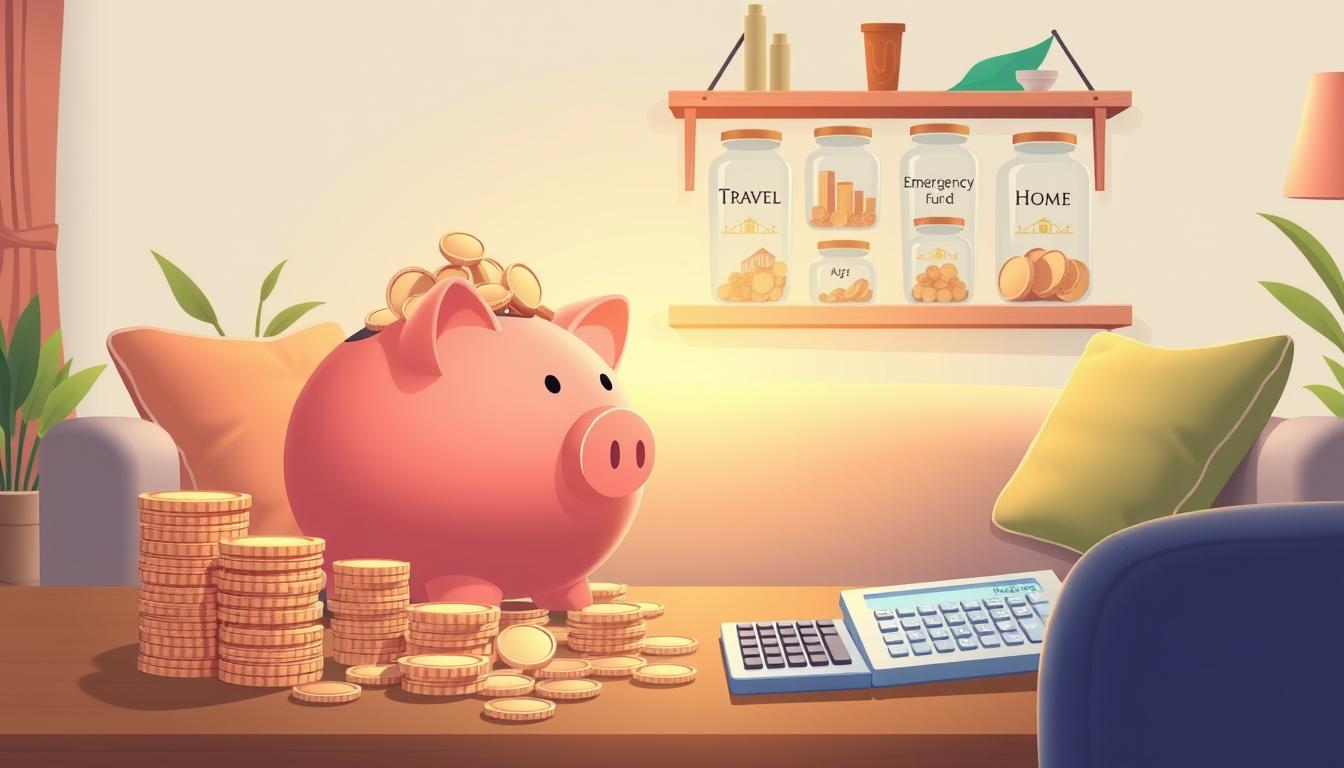Imagine nearly 60% of Americans can’t cover a $1,000 emergency from savings. This fact is alarming and calls for action. Many wonder how to build an emergency fund, given life’s unexpected costs.
Reaching financial stability is hard. It needs dedication, strategy, and a clear goal.
Emergencies don’t give us notice. They can cause financial stress. Savings act as a cushion, helping you deal with car repairs or job loss without debt.
Financial experts say aim for 3 to 6 months’ living expenses in savings.
The journey to financial stability begins with a small step. Even a $500 goal is a start. Today, I’ll share ways to build your emergency fund. This way, you can handle life’s surprises and sleep better at night.
Understanding the Importance of an Emergency Fund
An emergency fund is like a safety net for your money. It helps when you face unexpected costs like a job loss or car repair. It’s key to have money ready for these surprises.
What Constitutes an Emergency Fund?
An emergency fund is money saved in a bank account for sudden needs. It should be easy to get to without losing any money. It’s for things like medical bills or home repairs.
Why Every Household Needs to Prepare
Having an emergency fund means you’re ready for anything. Without it, you might have to use credit cards or loans. This could lead to debt. A good fund helps you deal with surprises without hurting your finances.
The Long-Term Benefits of Financial Security
Keeping an emergency fund helps you avoid debt and keeps your credit score good. It lets you handle unexpected costs without hurting your savings. This makes life more stable and lets you plan for the future.
Start with a small amount for small emergencies. Then, grow it to cover a few months of living costs. This builds a strong financial base for any crisis.
Remember, an emergency fund is a key part of planning your finances. It gives you a safety net for tough times, helping you stay on track with your long-term goals.
How to Build an Emergency Fund
Building an emergency fund is key to financial stability and peace of mind. Only 44% of Americans can cover a $1,000 emergency from their savings account. Starting to save more is essential.
It’s good to aim for three to six months’ expenses in your emergency fund. This helps avoid high-interest debt in emergencies. For example, 27% of those without a fund turn to credit cards.
- Assess your monthly spending to figure out how much to save for a three to six months’ target.
- Open a high-yield savings account to grow your savings. The average annual yield is competitive, encouraging more saving.
- Set up automatic transfers from your paycheck. This boosts savings by up to 25% by automating the process.
Even small savings add up over time. Saving $50 a month means $600 in a year. Starting small is a good way to grow your emergency fund. Regularly check and adjust your savings as your finances change.
Having an emergency fund brings big psychological benefits. People with funds feel 30% more secure financially. This is vital, as 58% of Americans have seen financial stress rise in the past year.
Begin with small goals and make regular savings deposits. As you save, your financial strength will grow. This lets you handle unexpected expenses without financial strain.
Strategies for Saving: Where to Start
Starting to build an emergency fund can seem hard. But, with the right steps, it’s easier. A clear plan helps you save more money.
Setting Realistic Savings Goals
First, know your financial situation. Aim to save $6,000 to $12,000 for three to six months of living costs. Choose a savings goal you can reach bit by bit. Saving $100 a month means $1,200 in a year, a great start.
Creating a Routine: The Path to Consistency
Consistency is key. Use automatic transfers to save money without thinking about it. Set these transfers for payday, so the money goes to savings before you spend it.
Utilizing Financial Tools and Resources
Good financial tools can help a lot. Open a high-yield savings account at a credit union for better interest rates. These accounts grow your savings faster. Also, think about a money market account for higher returns but with some access limits.
Also, put unexpected money like tax returns and bonuses into savings. This boosts your savings and shows you’re serious about your emergency fund.
Maximizing Your Savings: Tips and Tricks
I’ve found ways to boost my savings on my financial journey. A high-yield savings account is key for an emergency fund. It has better interest rates than regular accounts.
A money market account is also vital. It has high interest rates and easy access to your money. This helps grow your savings while keeping them safe.
Automatically saving from my paycheck is another strategy. It helps me save without thinking about it. This way, I save more and spend less.
- Putting up to 20% of my income into savings helps a lot. It builds my emergency fund and secures my future.
- Regular budget reviews with financial tools keep me on track. This helps meet both short-term and long-term savings goals.
- Joining savings challenges, like the 52-week money challenge, keeps me motivated. It encourages me to save more.
These strategies together help me build a strong financial safety net. Every dollar saved brings me closer to a more secure future.
Conclusion
Building an emergency fund is possible with the right steps. Financial experts say to save three to six months’ living costs. This is key to financial security.
It’s worrying that 44% of Americans struggle with a $400 emergency. But, this motivates me to help you reach your financial goals.
Start with saving $1,000, even if it seems hard. Saving $20 to $100 a month helps a lot. Remember, saving is a gradual process.
Regular savings, like from a side job or tax refund, helps build your fund. It’s not about quick savings, but steady ones.
Many Americans can’t handle a $1,000 surprise without credit. This shows why saving is so important. Have you figured out your monthly costs?
Whether it’s high-yield savings or more annual savings, the path is ongoing. But, each step brings you closer to financial safety. Taking charge of your money brings peace of mind.







